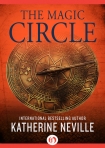The Magic Circle, Katherine Neville [parable of the sower read online .TXT] 📗

- Author: Katherine Neville
Book online «The Magic Circle, Katherine Neville [parable of the sower read online .TXT] 📗». Author Katherine Neville
“I’m not sure,” I admitted. “I grew up around the Nez Percé Indians. Their wisdom is the nearest to a religious education I’ve had. I guess I believe what they do, when it comes to an idea of a new age.”
I elaborated as we continued down the hall. “Like most tribes, the Nez Percé believe that Native Americans are the people chosen to bring the transition about. Late in the last century there was a prophet named Wovoka, a Nevada Paiute. During an illness, he had a vision that revealed to him what would happen at the end of time—which for the Paiute would mark the dawn of this new aeon. Wovoka was shown an inspired and visionary dance that enabled the people to cross the boundary between themselves and the spirit world. The people would hold hands and dance in a circle for five days, nonstop, each year. He called it Wanagi Wacipi, the Ghost Dance.
“The dancers invoke the son of the Great Spirit; he’ll arrive as a whirlwind and all Wasichu—you fork-tongued sons of Europeans, who trash everything you touch—will be totally blown away. The ancestral spirits will return to earth, along with all the bison that were slaughtered by white men. Mother Earth becomes bountiful once more and we live in harmony with nature, as it was seen in all the ancient visions.”
“It’s very beautiful,” said Wolfgang. “And this is what you yourself actually believe, this harmonic image of paradise regained?”
“I think it’s time for somebody to start believing in it,” I assured him. “Here on the third planet we’ve really fouled our own nest. That’s why I do the job I’ve chosen. Waste management is sort of my own purification ritual: helping clean things up.”
Sam had once observed that no civilization in history, however powerful, had survived for long without decent plumbing. Rome kept control of half the world through its aqueducts, water and waste systems. When Gandhi wanted to liberate India from the British, the first thing he did was to make everybody get down on hands and knees and scrub the toilets. When I said as much to Wolfgang, he laughed.
We’d reached the gate. He set down his briefcase inside the waiting area, and he touched his paper cup of tea against mine as if we were having a champagne toast. “Saving the world by controlling its waste is very much in keeping with the mission of my employer, the IAEA,” he said with a smile. “But at root, men are still everywhere the same. I fail to see how purifying oneself as the Mormons choose to, or cleaning up after others as Mohandas Gandhi did—or dancing on the grassy plains, as your American Indians recommend—will change human behavior very much or bring about global reform.”
“But we were talking about belief, not behavior,” I pointed out. “When things are brought down to earth, the results are never exactly as we’d planned. For example, to you the idea of the Ghost Dance seemed beautiful, but look what really became of it. The dance incorporated so many paradisical elements it was quickly embraced by the Arapaho, the Oglala, the Shoshone—and most especially the Lakota, who were the ones destroyed by it in the end.”
“What do you mean, destroyed?” said Wolfgang, looking confused.
“Why—they were killed,” I said in amazement. I found it hard to believe there was someone who knew nothing of the story at all. “It’s one of the bitterest subjects in the history of the Native Americans, but at base it resulted from conflicting beliefs. The people were prevented from hunting; they were rounded up and put on reservations and forced to farm. Then just before the turn of the century the great famine came. Thousands were starving, so they danced and danced. The dances became wild and ecstatically hysterical; the people went into trances, trying in desperation to bring back the idyllic, Arcadian past when the earth and her children were one. They believed the magical shirts they wore would repel soldiers’ bullets. White settlers were frightened by the new religion—they took these to be war dances—so the Ghost Dance was outlawed. When the Lakota found a more remote site to continue the dance, government troops rode in and cut down whole families, shot and butchered them: men, women, children, even tiny babies. You must have heard of the 1890 massacre of all the Ghost Dancers, at Wounded Knee?”
“Massacred?” said Wolfgang in horrified disbelief. “For dancing?”
“It does seem hard to imagine,” I agreed, adding with sarcasm, “but the federal government has usually taken a hard line on these regional issues.”
Then I kicked myself for seeming glib about something that was, as it deserved to be for Sam and most Native Americans, their own personal vision of the Holocaust and the Apocalypse rolled into one.
“That’s a truly astounding story,” said Wolfgang. “Then it seems that descendants of civilized white Europeans are the villains of the piece?”
“You’ve no idea,” I concurred. “But you did ask what I believed in, so I guess I’d have to go with conventional tribal wisdom: I wish there could be something like a Ghost Dance that would bring a renewal of harmony between us and our grandmother the earth, as Native Americans call her. Of course, I wouldn’t be much help myself in bringing it off: I’m not a very good dancer.”
Wolfgang smiled. “How can that be,” he said, “when your aunt Zoe was one of the greatest dancers of the century? And it seems you have many similar qualities. You’re designed like a dancer: your bones, the movement of your muscles, the way you ski, for example—”
“But I’m afraid to ski in the deep powder,” I pointed out. “I’m a control freak. You can’t be a control freak and be a really good dancer too. Sam’s mother—though I never met her—was full-blooded Nez Percé,” I said. “When we were young, Sam and I did the ceremony to become ‘blood brothers.’ I wanted to join the tribe and be





Comments (0)